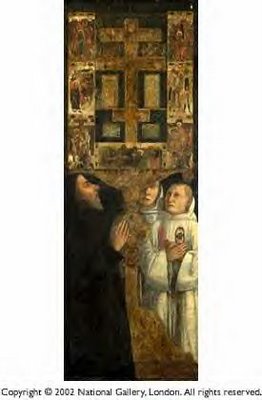
Cardinal Bessarion with the Bessarion Reliquary; Full title: Cardinal Bessarion and Two Members of the Scuola della Carità in prayer with the Bessarion Reliquary Egg tempera with gold and silver on panel 102.3 x 37.2 cm. National Gallery, London: National Gallery website
Gentile Bellini's (d. 1507) unusual group portrait was commissioned around 1472 when the Venetian confraternity of the Carità (Charity) received a Byzantine reliquary containing fragments of the True Cross from the Greek Cardinal Bessarion (1403 - 1472).
Bellini's picture (about 1472-3) was the door of the tabernacle in which the reliquary was stored. The keyholes at the right of the painting still bear witness to this function See below .
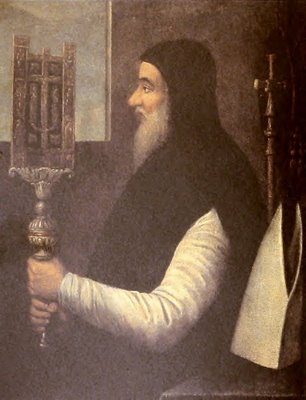
Next portrait painted by Berruguette to a design by Justus of Ghent. The work formed part of a series of famous men that Justus executed for Federico da Montefeltro's studiolo in his new palace in Gubbio
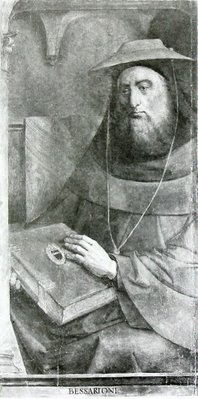
The next image shows Guillaume Fichet of Paris offering a copy of his book to Bessarion. Bessarion was instrumental in the establishment of printing in Rome.
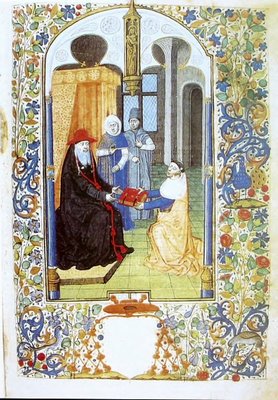
The two images below: Bessarion`s mansion in the South of Rome
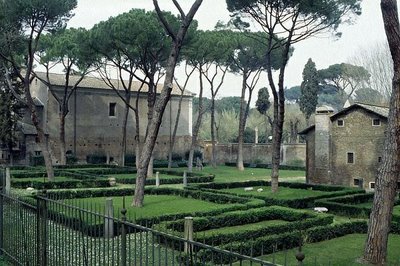
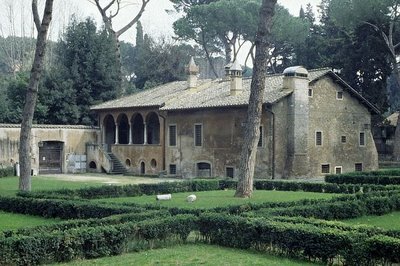
Bessarion`s tomb:
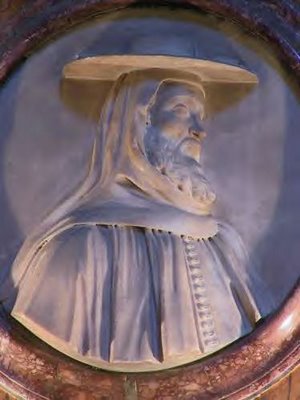
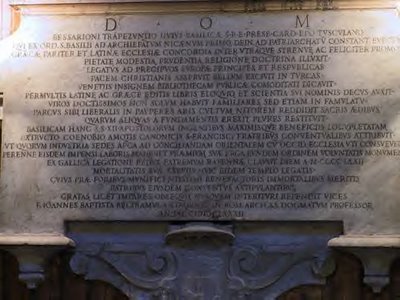
His funeral was held at Rome in the church of the Santi Apostoli, where he had erected for himself a marble tomb with a Greek inscription (not seen in the above) which Maiorano translated as follows:
I, Bessarion, raised this tomb to hide my bones; my soul will seek the stars whence once it came.
The Catholic Encyclopedia, Volume II Johannes Bessarion (Or BASILIUS). ;
Johannes Bessarion From Wikipedia;
Smith, Dictionary of Greek and Roman Biography and Mythology Dictionary of Greek and Roman Antiquities edited William Smith (1870)pages 589-591.,
In 1438 Bessarion (1403 - 1472) was sent by the Emperor John VIII Palaeologos to the Council of Ferrara/Florence to plead for western support in Constantinople's final struggle against the Ottoman Turks.
Despite the failure of the council to dispatch aid to Byzantine Empire, Pope Eugenius IV recognised Bessarion's constructive role in the deliberations by making him a cardinal.
Bessarion remained in Italy.
He was the owner of the largest and most important library of Greek books collected in Italy in the fifteenth Century, amounting to some five hundred volumes by the end of his life. These books and manuscripts were bequeathed by him to Venice and they formed the foundation of the Marcian Library there.
In Italy, he had three purposes: the union of the Oriental Church with the Latin; the rescue of Greek lands from the Turkish Empire, and the triumph of classic literature and philosophy, especially the Greek.
He achieved much, by his patronage of learned men, by his collection of books and manuscripts, and by his own writings, to spread abroad the new learning. His palazzo in Rome was a virtual Academy for the studies of new humanistic learning, a center for learned Greeks and Greek refugees, whom he supported by commissioning transcripts of Greek manuscripts and translations into Latin that made Greek scholarship available to Europeans. He supported Regiomontanus in this fashion and defended Nicholas of Cusa.
He was in the company of Trapezuntius, Gaza, Argyropoulus, Plethon, Filelfo, Biondo, Leonardo, Poggio, Valla, Sipontino, Campano, Platina, and Domizio.
He was twice nearly made Pope in two conclaves. He exercised influence in the conclaves he attended.
Pius II made use of him in trying to start the crusade against the Turks. He was often appointed by Popes in missions of importance.
For Diana Wright. Thanks you for the kind comments. As requested I attach a copy of the Greek epitaph on the Cardinal`s tomb:
Biographies of Bessarion can be accessed in the following, see:
The election of Pope Calixtus III (1455) ;
The election of Pope Sixtus IV (1472) ;
Bessarion, Orationes et epistolae ad Christianos principes contra Turcos (Orations and letters to Christian princes against the Turks) ;
Patron of Johann Müller Regiomontanus (astronomer) ;
Patron of Johann Müller Regiomontanus (astronomer)2 ;
Academy of Bessarion in Rome ;
Marcian library in Venice ;
The Effects of Greek Learning on the Italian Renaissance by Rose Rankin ;
Venice against Moscow for the legacy of Byzantium ;
AN ITALIAN PORTRAIT GALLERY Being BRIEF BIOGRAPHIES OF SCHOLARS Illustrious within the memory of our grand-fathers for the published monument of their genius by PAOLO GIOVIO on BESSARION ;
Byzantines in Renaissance Italy by Jonathan Harris (Hellenic Institute, Royal Holloway, University of London;
Remarkable theory connecting Regiomontanus, his Astrolaube, Bessarion and the Painting of "The Flagellation" by Piero della Francesca


Can you possibly find a photo of the Greek tomb inscription?
ReplyDeleteThis is a lovely page & I return to it often.
Thank you for drawing my attention to this old post.
ReplyDeleteFor some reason the text had been corrupted which I have now tidied up. Hopefully the entry makes better sense.
Hopefully the Greek text inscription is a suitable "thank you"
Thank you so much. My partner and I are writing on Bessarion just now. I have linked to you from
ReplyDeletehttp://nauplion.net/CP-BESSARION-portraits.html
Look for my thank-you for the image, and a more accurate translation of the Greek, on January 3, at http://suprisedbytime.blogspot.com
ReplyDeleteThank you very much and for directing my attention to a post which had become jumbled/corrupted for some reason
ReplyDeleteBest of luck to you and your partner
http://surprisedbytime.blogspot.com/2010/01/bessarions-nazi.html
ReplyDelete